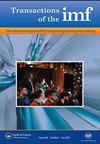The microstructure of WC-Co coatings produced by HVOF spraying with liquid fuel
IF 1.5
4区 材料科学
Q4 ELECTROCHEMISTRY
Transactions of The Institute of Metal Finishing
Pub Date : 1997-01-01
DOI:10.1080/00202967.1997.11871153
引用次数: 13
Abstract
High velocity oxy-fuel (HVOF) spraying is now frequently used to produce high quality WC-Co coatings on surfaces which are subjected to certain kinds of erosive wear in service. An examination has been made of coatings produced by modified HVOF technology which makes use of liquid fuels rather than gaseous ones employed hitherto. It has been demonstrated that liquid fuel, i.e. diesel, promotes higher temperatures in the spray stream and this gives rise to an increased level of WC decomposition. Coatings contain reacted and unreacted zones and a model has been developed to account for their distribution. Observations on the coatings have demonstrated the composition of reaction products, i.e. W 2 C, Wand also a solid solution of carbon and tungsten in the cobalt matrix which is amorphous as a result of rapid cooling when the spray particles impact with the substrate. The coatings produced have lower porosity levels and higher hardness values than those associated with conventional plasma spraying.液体燃料HVOF喷涂WC-Co涂层的微观结构
高速氧燃料(HVOF)喷涂现在经常用于在使用中遭受某些侵蚀磨损的表面上生产高质量的WC-Co涂层。对利用液体燃料而不是迄今为止使用的气体燃料的改进HVOF技术生产的涂层进行了研究。已经证明,液体燃料,即柴油,在喷雾流中促进更高的温度,这导致WC分解水平增加。涂层包含反应区和未反应区,并开发了一个模型来解释它们的分布。对涂层的观察表明了反应产物的组成,即w2c, Wand也是碳和钨在钴基体中的固溶体,当喷雾颗粒与基体碰撞时,由于快速冷却而形成无定形。与传统的等离子喷涂相比,该涂层具有更低的孔隙率和更高的硬度值。
本文章由计算机程序翻译,如有差异,请以英文原文为准。
求助全文
约1分钟内获得全文
求助全文
来源期刊

Transactions of The Institute of Metal Finishing
工程技术-材料科学:膜
CiteScore
3.40
自引率
10.50%
发文量
62
审稿时长
3 months
期刊介绍:
Transactions of the Institute of Metal Finishing provides international peer-reviewed coverage of all aspects of surface finishing and surface engineering, from fundamental research to in-service applications. The coverage is principally concerned with the application of surface engineering and coating technologies to enhance the properties of engineering components and assemblies. These techniques include electroplating and electroless plating and their pre- and post-treatments, thus embracing all cleaning pickling and chemical conversion processes, and also complementary processes such as anodising. Increasingly, other processes are becoming important particularly regarding surface profile, texture, opacity, contact integrity, etc.
 求助内容:
求助内容: 应助结果提醒方式:
应助结果提醒方式:


